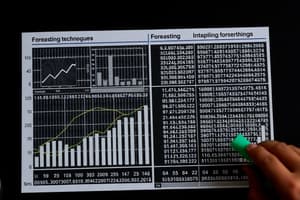Podcast
Questions and Answers
What distinguishes simple random sampling from other sampling methods?
What distinguishes simple random sampling from other sampling methods?
- It selects members based on convenience.
- It is the least reliable form of sampling.
- It ensures every member has an equal and known chance of being selected. (correct)
- It allows each member an unequal chance of selection.
Which of the following methods involves selecting members based on specific criteria or judgment?
Which of the following methods involves selecting members based on specific criteria or judgment?
- Stratified sampling
- Quota sampling
- Convenience sampling
- Purposive sampling (correct)
What is a primary characteristic of cluster sampling?
What is a primary characteristic of cluster sampling?
- It requires complete population data for selection.
- It ensures an equal chance of selection across all population members.
- It's focused on small, homogeneous groups.
- It randomly selects entire groups rather than individuals. (correct)
How does multistage sampling differ from stratified sampling?
How does multistage sampling differ from stratified sampling?
Which sampling method is considered less costly and labor-intensive by collecting data from a whole sample and then a subsample?
Which sampling method is considered less costly and labor-intensive by collecting data from a whole sample and then a subsample?
Which of the following statements about forecasts is accurate?
Which of the following statements about forecasts is accurate?
Which type of data is considered categorical?
Which type of data is considered categorical?
Which of the following forecasting models is based on subjective assessment?
Which of the following forecasting models is based on subjective assessment?
What is NOT a common characteristic of forecasting?
What is NOT a common characteristic of forecasting?
Which component is NOT included in the historic pattern of time series data?
Which component is NOT included in the historic pattern of time series data?
Which of the following is true about the naïve forecasting method?
Which of the following is true about the naïve forecasting method?
What is the focus of quantitative forecasting methods?
What is the focus of quantitative forecasting methods?
Which step is NOT typically part of the forecasting process?
Which step is NOT typically part of the forecasting process?
Which method would provide a forecast that is more responsive to recent changes?
Which method would provide a forecast that is more responsive to recent changes?
What formula accurately represents forecast error?
What formula accurately represents forecast error?
What is the primary characteristic of the Mean Absolute Deviation (MAD)?
What is the primary characteristic of the Mean Absolute Deviation (MAD)?
In tracking forecast errors, what does a positive tracking signal indicate?
In tracking forecast errors, what does a positive tracking signal indicate?
Which of the following sampling methods gives each member of the population a known non-zero probability of selection?
Which of the following sampling methods gives each member of the population a known non-zero probability of selection?
What characteristic of a larger N in moving averages is highlighted?
What characteristic of a larger N in moving averages is highlighted?
What does the combined weight in a weighted moving average forecast need to total?
What does the combined weight in a weighted moving average forecast need to total?
Which measure penalizes extreme forecast errors more heavily?
Which measure penalizes extreme forecast errors more heavily?
Flashcards
Statistical Forecasting
Statistical Forecasting
Forecasting methods using mathematical modeling to predict future values based on historical data.
Qualitative Forecasting
Qualitative Forecasting
Forecasting methods based on expert opinions and subjective judgments.
Time Series Data
Time Series Data
Data collected over a period of time.
Naïve Forecasting
Naïve Forecasting
Signup and view all the flashcards
Simple Mean Forecasting
Simple Mean Forecasting
Signup and view all the flashcards
Moving Average Forecasting
Moving Average Forecasting
Signup and view all the flashcards
Level (Forecasting)
Level (Forecasting)
Signup and view all the flashcards
Trend (Forecasting)
Trend (Forecasting)
Signup and view all the flashcards
Seasonality (Forecasting)
Seasonality (Forecasting)
Signup and view all the flashcards
Cycle (Forecasting)
Cycle (Forecasting)
Signup and view all the flashcards
Moving Average Forecast
Moving Average Forecast
Signup and view all the flashcards
Weighted Moving Average
Weighted Moving Average
Signup and view all the flashcards
Forecast Error
Forecast Error
Signup and view all the flashcards
Mean Absolute Deviation (MAD)
Mean Absolute Deviation (MAD)
Signup and view all the flashcards
Mean Squared Error (MSE)
Mean Squared Error (MSE)
Signup and view all the flashcards
Tracking Signal
Tracking Signal
Signup and view all the flashcards
Population
Population
Signup and view all the flashcards
Sample
Sample
Signup and view all the flashcards
Probability Sample
Probability Sample
Signup and view all the flashcards
Nonprobability Sampling
Nonprobability Sampling
Signup and view all the flashcards
Convenience Sampling
Convenience Sampling
Signup and view all the flashcards
Judgment Sampling
Judgment Sampling
Signup and view all the flashcards
Quota Sampling
Quota Sampling
Signup and view all the flashcards
Snowball Sampling
Snowball Sampling
Signup and view all the flashcards
Simple Random Sampling
Simple Random Sampling
Signup and view all the flashcards
Systematic Random Sampling
Systematic Random Sampling
Signup and view all the flashcards
Stratified Random Sampling
Stratified Random Sampling
Signup and view all the flashcards
Cluster Sampling
Cluster Sampling
Signup and view all the flashcards
Multistage Sampling
Multistage Sampling
Signup and view all the flashcards
Multiphase Sampling
Multiphase Sampling
Signup and view all the flashcards
Study Notes
Webinar: Forecasting and Sampling Techniques
- Webinar title: SAKSHAM: IL6 Webinar for Logistics, "Forecasting and Sampling Techniques"
- Presenter: Priyendu N Giri
- Contact: 7077762551
- Company: Tata Steel
Basics of Statistics
- Types of Data:
- Numerical (Discrete & Continuous)
- Categorical (Nominal & Ordinal)
- Statistical Measures:
- Mean, Median, Mode
- Variance, Standard Deviation
- Dependent and Independent Variables
- Correlation
Decisions Requiring Forecasting
- Examples:
- Which markets to pursue?
- What products to produce?
- How many people to hire?
- How many units to purchase?
- How many units to produce?
- ...and more...
Common Characteristics of Forecasting
- Forecasts are rarely perfect
- Forecasts are more accurate for aggregated data than for individual items
- Forecasts are more accurate for shorter than longer time periods
Forecasting Steps
- Define what needs to be forecast (level of detail, units of analysis, time horizon)
- Identify available data and evaluate its suitability
- Select and test a forecasting model (considering cost, ease of use, and accuracy)
- Generate the forecast
- Monitor forecast accuracy over time
Types of Forecasting Models
- Qualitative: Forecasts generated subjectively by the forecaster
- Quantitative (Statistical): Forecasts generated through mathematical modeling
Qualitative Forecasting Models
- Executive opinion: A group of managers provides a forecast
- Market research: Surveys and interviews used to identify customer preferences
- Delphi method: Eliciting consensus among experts
Statistical Forecasting Models
- Time Series Models:
- Assume future follows past patterns
- Single variable models
- Machine learning models
- Causal Models:
- Explore cause-and-effect relationships
- Use leading indicators to predict the future
- Use independent/feature variables to forecast dependent/target variables
Composition of Time Series Data
- Data = historic pattern + random variation
- Historic pattern may include:
- Level (long-term average)
- Trend
- Seasonality
- Cycle
Time Series Patterns
- Level or Horizontal Pattern: Data varies around a consistent mean value
- Trend Pattern: Data shows a consistent upward or downward movement over time
- Seasonal Pattern: Data exhibits a regularly repeating pattern over time
- Cycle Pattern: Data displays a repetitive but non-fixed pattern of increases and decreases over a longer period
Level Forecasting Methods
- Naïve Forecasting
- Simple Mean
- Moving Average
- Weighted Moving Average
- Exponential Smoothing
Time Series Example Problem
- Includes data and demonstrates various forecasting methods
Forecast Accuracy
- Forecasts are rarely perfect
- Need to measure forecast error (E = A - F)
- Over forecasts: negative error
- Under forecasts: positive error
Tracking Forecast Error
- Mean Absolute Deviation (MAD)
- Mean Square Error (MSE)
Accuracy and Tracking Signal Example:
- Data comparison, Methods A & B
- Measurement of MAD and MSE
- Tracking Signal
- Review of forecast accuracy
Sampling Techniques
- Population: Collection of elements we wish to make inferences about
- Sampling Units: Non-overlapping collections of elements that cover the entire population
- Probability Sampling:
- Each member has a known non-zero probability of selection
- Random sampling, systematic sampling, stratified sampling
- Non-probability Sampling:
- Selection is not random; includes convenience sampling, judgment sampling, quota sampling, snowball sampling
Sampling for Population
- Study Population: Collection of subjects relevant to the investigation
- Target Population: The wider group being studied, which data generalizes to
- Sampling Frame: A complete list of all elements in the study population
- Sample: A subset of the study population selected for analysis
Simple Random Sampling
- Purest form of probability sampling
- Each member has an equal chance of selection
- Useful when populations are manageable
Systematic Random Sampling
- Every nth member is selected
- Good when a complete list is available
- May not be truly random if underlying order exists
Stratified Random Sampling
- Population segmented by strata (groups)
- Proportional representation ensures all strata are adequately represented
- Varied sampling fractions within strata are possible; important in minority groups
Cluster Sampling
- Population divided into clusters
- Random sample of clusters is selected
- All or some units are then selected from the selected clusters
- Useful when a complete list is impractical
Multistage Sampling
- Complex cluster sampling; multiple stages of random sampling
- Subsamples from clusters are randomly selected at each stage
- Useful for larger populations where complete list is missing
Multiphase Sampling
- Collecting information from whole & part of a sample at different phases
- Useful for costly or complex data collection processes
Convenience Sampling
- Selection based on ease and accessibility
Judgmental or Purposive Sampling
- Selection based on researcher judgment
- Researcher must ensure sample reflects population
Quota Sampling
- Aims for proportion in sub-groups; like stratified; but selection non-random
Snowball Sampling
- Initial subjects recruit additional subjects
- Useful for rare or hidden populations
Studying That Suits You
Use AI to generate personalized quizzes and flashcards to suit your learning preferences.




